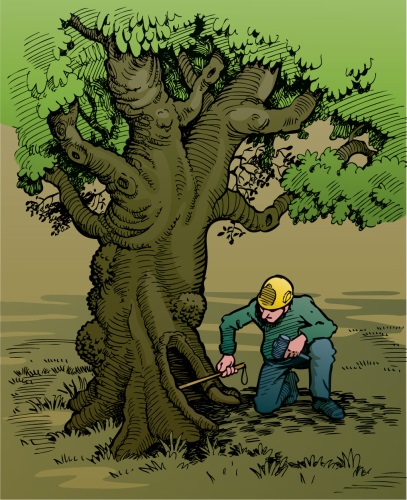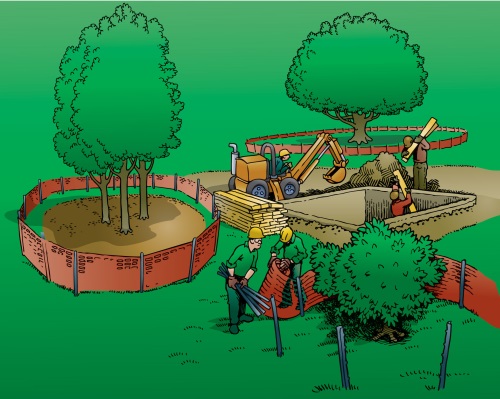Managing Hazards and Risk
Trees provide numerous benefits to those living and working in the urban environment, which increase with tree size and age. However, older and larger trees are also more likely to drop branches or cause root conflicts on the sites they inhabit. In managing these trees, tree owners must recognize the tree benefits and risks.
Whether hazards are created by strong winds or ice-storms, or whether construction on the site may or already has negatively affected the tree, tree owners should recognize tree risk and management strategies to help ensure trees are able to provide their full complement of benefits.
Click on these links to find out more about recognizing tree risk, safely responding to storm-related tree damage, avoiding damaging trees during construction, and treating trees injured during construction.
Recognizing Tree Risk

Trees provide significant benefits to our homes and cities, but when trees fall and injure people or damage property, they are liabilities. Understanding and addressing the risks associated with trees makes your property safer and prolongs the life of the tree.
An arborist can help you manage the trees on your property and can provide treatments that may help reduce the risk associated with certain trees. An arborist familiar with tree risk assessment may suggest one or more of the following:
- Remove the target. While a home or a nearby power line cannot be moved, it is possible to move picnic tables, cars, landscape features, or other possible targets to prevent them from being hit by a falling tree.
- Prune the tree. Remove the defective branches of the tree. Because inappropriate pruning may weaken a tree, pruning work is best done by an ISA Certified Arborist.
- Cable and brace the tree. Provide physical support for weak branches and stems to increase their strength and stability. Such supports are not guarantees against failure.
- Provide routine care. Mature trees need routine care in the form of water, nutrients (in some cases), mulch, and pruning as dictated by the season and their structure.
- Remove the tree. Some trees with unacceptable levels of risk are best removed. If possible, plant a new tree in an appropriate place as a replacement.
Learn more about recognizing tree risk.
Find an arborist who is ISA Tree Risk Assessment Qualified.
Safe Response to Tree-Related Storm Damage
Severe weather can have a lasting impact on your home and the trees in the surrounding landscape. Tearing winds and penetrating rains work together, softening soils and overturning trees. Lightning strikes generate heat that vaporizes water within the tree, causing wood to split and bark to explode. During a storm, the failure of part or all of one mature tree may cause significant damage to personal property or utility lines.
Tree owners can follow these steps to help ensure a safe and effective response to tree-related storm damage:
- Assess the damages
- Take safety precautions
- Resist the urge to do it yourself
- Hire an ISA Certified Arborist
Learn more about the safe response to storm-related tree damage.
Avoiding Tree Damage During Construction

Homes are often constructed near existing trees to take advantage of their aesthetic and environmental value. Unfortunately, the processes involved with construction can be deadly to nearby trees. Proper planning and care are needed to preserve trees on building sites. An arborist can help you decide which trees can be saved. The arborist can also work with the builder to protect the trees throughout each phase of construction.
Learn more about the avoiding tree damage during construction.
Planning
Your arborist and builder should work together early in the planning phase of construction. Sometimes small changes in the placement or design of your house or driveway can make a great difference in whether a critical tree will survive. If utilities cannot be re-routed away from trees, less damaging tunneling and trenching installation techniques exist.
Erect Barriers to Limit Access
Prior to the start of work, an arborist can recommend where tree protection fences should be installed. Fences should have signs attached to inform people of why they should stay out and who to contact if they need to get in. If machinery must come close to a tree trunk, an arborist can recommend how the trunk can be protected from damage with additional protection materials. If there will be trenching, grading or other excavation near trees that may damage roots, an arborist can prune roots out of the way before excavation, or cleanly cut them before any damage is done.
Treatment of Trees Damaged by Construction
The processes involved in construction can be devastating to the surrounding trees if no measures have been taken to protect them. Remedial treatments may save some construction-damaged trees, but immediate implementation is critical. If you have trees that have been affected by recent construction, a professional arborist can assess tree viability and risk potential and recommend treatment options.
Learn more about the treatment of trees damaged during construction.
Inspection and Assessment
Because construction damage can affect the structure and stability of a tree, your arborist should check for potential risks. A risk inspection may involve a simple visual inspection, or instruments may be used to check for the presence of decay. Identified risks can sometimes be reduced or eliminated by removing an unsafe limb, pruning to reduce weight, or installing cables or braces to provide structural support.
Common damage caused during construction includes:
- physical injury to the trunk and crown
- soil compaction in the root zone
- severed roots
- smothered roots from addition of fill soil
- increased wind and sunlight exposure
- stress due to grade and drainage changes
Treating Trunk and Crown Injuries
- Pruning. Split, torn, or broken branches should be removed. Also, remove any dead or diseased limbs from the crown of the tree. It is best to postpone other maintenance pruning, such as crown raising, for a few years. Do not thin or reduce tree canopies to compensate for root loss.
- Cabling and Bracing. If branches or tree trunks need additional support, a professional arborist may be able to install cables or bracing rods. If cables or braces are installed, they must be inspected regularly. The amount of added security offered by the installation of support hardware is limited. Not all weak limbs are candidates for these measures.
- Treating Damaged Bark and Trunk Wounds. Bark may be damaged along the trunk or on major limbs. If this happens, remove the loose bark. Jagged edges can be cut away with a sharp knife. Take care not to cut into living tissues.
- Irrigation and Drainage. One of the most important tree maintenance procedures following construction damage is to maintain an adequate, but not excessive, supply of water to the root zone. Water trees as needed, especially during the dry summer months. A long, slow soak over the entire root zone is the preferred method of watering. Avoid frequent, shallow watering or overwatering. Poor drainage must be corrected or trees will decline rapidly.
- Mulching. Apply a 2- to 4-inch layer of organic mulch such as wood chips, shredded bark, or pine needles over a tree’s root system for a simple and effective means of enhancing root growth. The mulch helps condition the soil, moderates soil temperatures, maintains moisture, and reduces competition from weeds and grass. The mulch should extend as far out from the tree as practical for the landscape site.
Monitoring for Decline and Risk
Despite your best efforts, you may lose some trees from construction damage. Symptoms of decline include smaller and fewer leaves, dieback in the crown of the tree, and premature fall color. Stressed trees are more prone to attack by certain diseases and pests, which further a tree’s downward spiral. Severe damage and decline may also lead to defects and decay. Consult with an arborist for a professional assessment if you are concerned with your tree’s health or structural integrity.
Learn more about the treatment of trees damaged during construction.